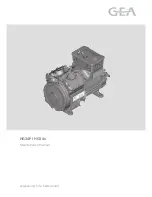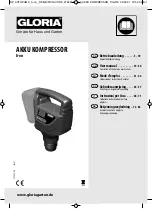
Book 22091102 (12/01)
35
( )
As the pressure is slowly decreased to 8 psi (0.56 kgf
per cm2) the contacts should open and the ohmmeter
should show lack of continuity (infinite ohms) through
the contacts. Replace a defective switch before
continuing to operate the unit.
COMPRESSOR OIL COOLER
The compressor lubricating and cooling oil is cooled by
means of the fin and tube--type oil cooler, located
beside the radiator. The lubricating and cooling oil,
flowing internally through the core section, is cooled by
the air stream from the cooling fan flowing past the
core section. When grease, oil and dirt accumulate on
the exterior surfaces of the oil cooler, its efficiency is
impaired.
Each month it is recommended that the oil cooler be
cleaned by directing compressed air which contains a
nonflammable safety solvent through the core of the
oil cooler. This should remove the accumulation of
grease, oil and dirt from the exterior surfaces of the oil
cooler core so that the entire cooling area can transmit
the heat of the lubricating and cooling oil to the air
stream.
In the event foreign deposits, such as sludge and
lacquer, accumulate in the oil cooler to the extent that
its cooling efficiency is impaired, a resulting high
discharge air temperature is likely to occur, causing
shut down of the unit. To correct this situation it will be
necessary to clean it using a cleaning compound in
accordance
with
the
manufacturer’s
recommendations. Use only a dependable cleaning
compound. This is of prime importance because
different cleaners vary in concentration and chemical
composition.
After completing the cleaning
procedure, the oil cooler must be flushed before
returning to service.
RADIATOR
WARNING
Do not remove the cap from a HOT engine radia-
tor.
The sudden release of pressure from a
heated cooling system can result in a loss of cool-
ant and possible severe personal injury.
The engine cooling system is filled at the factory with a
50/50 mixture of water and ethylene glycol. This
permanent type antifreeze contains rust inhibitors and
provides protection to --35
°
F (--37
°
C). The use of such
a mixture is recommended for both summer and
winter operation. When using water alone, be sure to
add a reputable brand of rust inhibitor to prevent
internal corrosion.
It is recommended to test the freezing protection of the
coolant every six months or prior to freezing
temperatures. Replenish with a fresh mixture every
twelve months. A drain for the system is located in the
bottom radiator tank. An alternate method would be to
disconnect a bottom radiator hose.
Each month, inspect the radiator exterior for
obstructions (dirt, bugs, etc.). If present, blow water or
compressed air containing a nonflammable solvent
between the fins in a direction opposite the normal air
flow. Should the radiator be clogged internally,
standard automotive practices should be followed.
HOSES
Each month it is recommended that all of the intake
lines to and from the air cleaners, the engine cooling
system hoses and all of the flexible hoses used for air,
oil, and fuel be inspected.
To ensure freedom from air leaks, all rubber hose
joints and the screw--type hose clamps must be
absolutely tight.
Regular inspection of these
connections for wear or deterioration is a definite
“must” if regulator servicing of the air cleaners is not to
prove futile.
















































